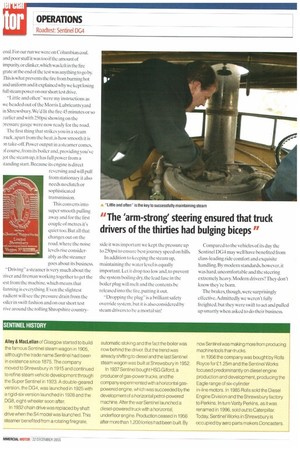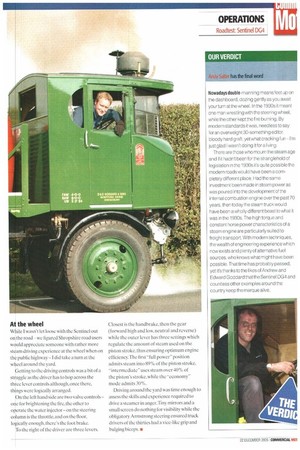SENTIMENTAL JOURNEY
Page 62

Page 64

Page 65

Page 66

Page 67

If you've noticed an error in this article please click here to report it so we can fix it.
As the inaugural issue of CM was rolling off the press, Sentinel was building its first steamer. To mark the occasion Andy Salter took a turn as fireman...
Given the comfort levels in today's trucks, it's hard to imagine a time when steam power was the norm and the driver and his mate sat next to the fire and boiler,surrounded by coal dust.smoke and noise, but things have moved on since then.
These days the truck manufacturers are spending millions searching for the latest in alternative power sources, improved efficiency and automated transmissions. The steam truck, though now very much consigned to history for automotive applications, offered the solution to many of these technical problems.
However, in the battle for technical supremacy the legislators turned against steam. Despite steam trouncing diesel-fuelled trucks on reliability they had a reputation, not altogether unwarranted given the state of your correspondent after the test, for being dirty and smelly affairs.Thus the battle was lost.
Steam trucks do, however, have a keen following among the preservation ranks and one of the best examples we've come across is the Sentinel DG4 steamer in the colours of Morris Oils,Shrewsbury, which is owned by the Goddard family. We spotted it at this year's Cart Marking Ceremony in London (see report, page 72) and headed to Shrewsbury in October to find out more.
Specification
Our Sentinel DG4 "test" truck, built in 1931, was one of the first Sentinel steamers to he equipped with pneumatic tyres—giving the DG4 a speed advantage over an equivalent solid-tyred machine.The DG had originally em n launched in 1927 and, as well as the four/heeler, a rigid six and eight-legger followed.
DG's engine was developed from the riginal Super Sentinel's two-cylinder steam ngine, benefiting from a slight reduction in the ore and stroke of the engine, which gave faster !vs and reduced weight.
The two-speed gearing was an improvement ver the Super Sentinel's single geared affair. entinel claimed at the time that the total riveline.with all its added benefits,gave rtually the equivalent driveability of a raight eight (four-stroke) petrol engine with x-speed transmission, but with even more Dwer and flexibility because it was steam lven.
The boiler was improved, raising the orking pressure from 230 to 275psi and in sts carried out at the time the combination G engine and boiler developed more than ilip on the steam consumption of 141b of earn per hp/hour. The DG4 is equipped with a 6in deep chassis frame made of high grade rolled steel channel. The engine and gearbox unit is suspended at three points from the frame —by a flexible steel hanger at the front end of the cylinders, by spherical hearings at the front end of the cylinders, and more spherical bearings at the gearbox end.
Ackerman steering was used, with an Isection axle carried on long semi-elliptic springs.The turning circle of the DG4 was 17.1m. somewhat wider than a typical fourwheeler of today. yet good for its age.
Morris Lubricants ran a number of Sentinels over the years. though it never actually operated a DG4.The company's Sentinels included a Super Sentinel,DG6s and shaft driven S4s. Our test example was originally new to Samuel Banner in Liverpool,before moving to Paul Brothers, the millers based in Liverpool, and spent much of its working life running around the docks in the north west, In 1949 it was placed into preservation and owned by Edgar Shone, who saved a lot of Sentinels from dereliction.
In 1977 Shrewsbury oil distributors and blenders Morris Lubricants bought the truck and it can now he seen at many of the steam engine and commercial vehicle shows and events which are held around the country.
On the road It's unlikely you'll include -be a fireman on a Sentinel steam truck" on your list of things to do before you're 60, but if ever you do get the chance to be one then take it from me,you will not be disappointed.
Sure the working conditions are cramped, smoky and noisy, but if you've got even half a passion for things mechanical then the roar of the fire, the hiss and spit of the steam and the fantastic noise of the whole flaming affair can't help but excite you.
The biggest problem with running a steam truck these days, according to Edward Goddard, is getting good coal. Privately we suspect he may have said the same thing about a good fireman, but he was much too polite!
Maggie Thatcher and Arthur Scargill put paid to the UK's volume coal production, and while South Wales coal is best for steaming it's rarer than hen's teeth. Nottinghamshire coal is next best when it comes to performance, but the resultant smoke tends to upset the local environmentalists.
These days Morris's steamer runs on imported In-cab conditions are a far cry from the interior 01 a modem truck coal. For our run we were on Columbian coal, and poor stuff it was too if the amount of impurity, or clinker, which was left in the fire grate at the end of the test was anything to go by. 'Ibis is what prevents the fire from burning hot and uniform and it explained why we kept losing full steam power on our short test drive.
"Little and often" were my instructions as we headed out of the Morris Lubricants yard in Shrewsbury. We'd lit the fire 45 minutes or so :.arlier and with 250psi showing on the ?ressure gauge were now ready for the road.
The first thing that strikes you in a steam ruck, apart from the heat, is how smooth it is At take-off. Power output in a steamer comes. 31' course, from its boiler and, providing you've tot the steam up, it has full power from a itanding start. Because its engine is direct reversing and will pull from stationary it also needs no clutch or sophisticated transmission.
This converts into super smooth pulling away and for the first couple of metres it's quiet too. But all that changes out on the road, where the noise levels rise considerably as the steamer goes about its business.
"Driving" a steamer is very much about the [river and fireman working together to get the 'est from the machine, which means that ■ lanning is everything. Even the slightest radient will see the pressure drain from the oiler in swift fashion and on our short test rive around the rolling Shropshire country side it was important we kept the pressure up to 250psi to ensure best journey speed on hills.
In addition to keeping the steam up, maintaining the water level is equally important. Let it drop too low and, to prevent the system boiling dry, the lead fuse in the boiler plug will melt and the contents be released into the fire, putting it out.
"Dropping the plug" is a brilliant safety override system, but it is also considered by steam drivers to be a mortal sin! Compared to the vehicles of its day the Sentinel DG4 may well have benefited from class-leading ride comfort and exquisite handling. By modern standards, however, it was hard, uncomfortable and the steering extremely heavy. Modern drivers? They don't know they're born.
The brakes, though, were surprisingly effective. Admittedly we weren't fully freighted. but they were swift to act and pulled up smartly when asked to do their business.
At the wheel
While I wasn't let loose with the Sentinel out on, the road we figured Shropshire road users wOuld appreciate someone with rather more steam driving experience at the wheel when on the public highway-I did take a turn at the wheel around the yard.
Getting to the driving controls was a bit of a struggle as the driver has to hop across the three lever controls although,once there, things were logically arranged.
On the left hand side are two valve controlsone for brightening the tire, the other to operate the water injector-on the steering column is the throttle,and on the floor, logically enough, there's the foot brake.
To the right of the driver are three levers. Closest is the handbrake, then the gear (forward high and low, neutral and reverse) while the outer lever has three settings which regulate the amount of steam used on the piston stroke, thus ensuring optimum engine efficiency. The first "full power" position admits steam into 89% of the piston stroke, "intermediateuses steam over 40% of the piston's stroke, whi le the "economy" mode admits 30%.
Driving around the yard was time enough to assess the skills and experience required to drive a steamer in anger.Tiny mirrors and a small screen do nothing for visibility while the obligatory Armstrong steering ensured truck drivers of the thirties had a vice-like grip and bulging biceps. • Nowadays double-manni ng means feet up on the dashboard, dozing gently as you await your turn at the wheel. In the 1930s it meant one man wrestling with the steering wheel, while the other kept the fire burning. By modern standards it was, needless to say for an overweight 30-something editor, bloody hard graft, yet what cracking fun I'm just glad I wasn't doing it for a hying.
There are those who mourn the steam age and if it hadn't been for the stranglehold of legislation in the 1930s it's quite possible the modern roads would have been a completely different place. Had the same investment been made in steam power as was poured into the development of the internal combustion engine over the past 70 years, then today the steam truck would have been a wholly different beast to what it was in the 1930s. The high torque and constant horse power characteristics of a steam engine are particularly suited to freight transport. With modern techniques, the wealth of engineering experience which now exists and plenty of alternative fuel sources, who knows what might have been possible. That time has probably passed, yet it's thanks to the likes of Andrew and Edward Goddard that the Sentinel DG4 and countless other examples around the country keep the marque alive.




























































































































































































